Visuals: Challenging ‘The State of Things’

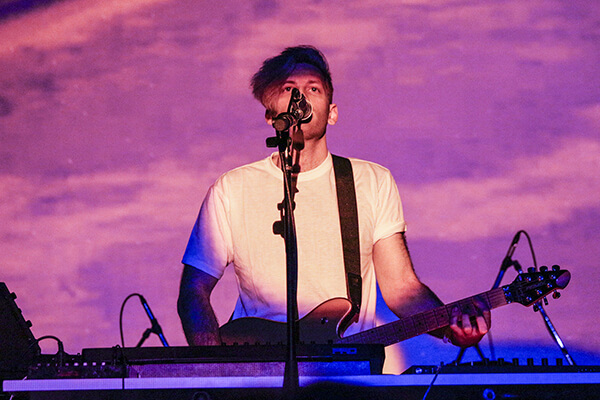
I met Andrew Fox in the backyard of Outpost, a Bedstuy space that is equal parts coffee shop and tavern. Fox, who makes music under the moniker Visuals, arrived wearing a t-shirt beneath a dark leather jacket. The black, wavy crest of his undercut hung loosely over one eye, further shading his five o’clock shadowed jaw.
The multi-instrumentalist recently returned home to New York after spending time composing in Berlin. NYC’s plentiful network of creatives—particularly long-time friend and collaborator Dave Harrington (of Darkside)—drew Fox back to the city. Harrington and Fox have been friends for more than a decade, often producing one another’s material. Harrington most recently did some post-production work on Fox’s new EP, The State of Things, which arrived March 25 via Berlin-based label, thesongsays.
–
The new record blurs a lot of boundaries. The energy of the Berliner techno scene is just as present as the Brooklyn indie aesthetic that surrounded Fox in the aughts. Influence, in addition to place, is just as varied, and he cited both David Bowie and seminal producer Jon Hopkins as paramount inspirations for TSOT. He likes Hopkins’ style because he’s “not an obvious dance guy doing his thing, he kind of punks out,” and Fox’s music, too, exists in that unnamed in-between.
Berlin, he says, is accommodating that stylistic overlap, fielding venues where indie and dance music can naturally coalesce. New York’s own venues, though, are still largely affiliated with one or the other. That will change—New York never falls far from vogue—but it’ll take acts like Visuals to catalyze the movement. His excellent album release show at the Bowery Ballroom last Saturday was a good start. Channeling the dynamism of Bowie, the profuse electronic textures of Hopkins, and the dance-first indie composition of James Murphy, Fox exhibited the kind of music that New York will soon need to make space for.
Read on to learn more about one of the musicians at the vanguard of New York’s ever-shifting music scene.
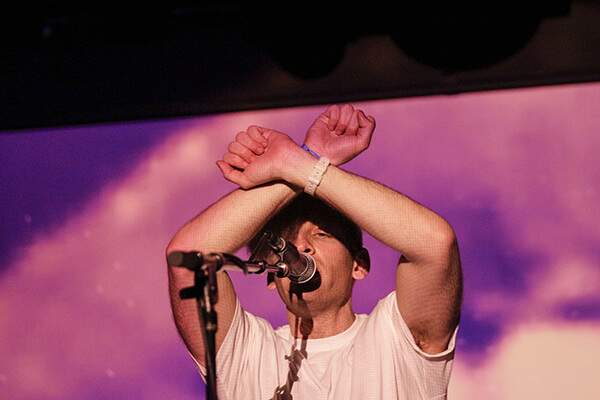
How did you first get into music? What was the origin?
A. It’s just always been around the house. My mother had guitars lying around that I would play from a very young age. I think I began playing guitar at the age of 8, maybe started writing songs around 10 or 11. It was so primary. There wasn’t really a moment where there was a light bulb that switched. There was always music. Around 15 I started taking it more seriously, seeing songwriting as something I could do for the rest of my life.
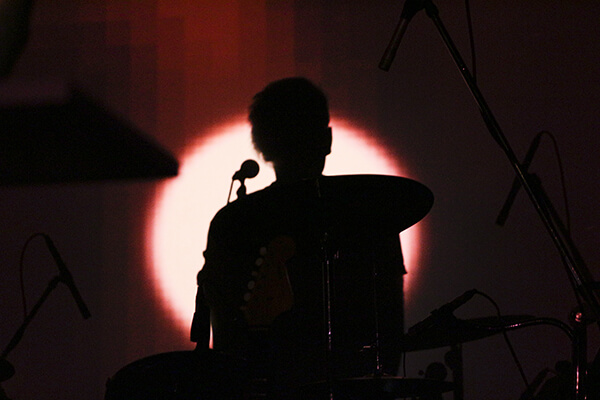
When did you start getting into electronic music and production?
A. My first gig in New York, when I was like 18, was at a studio called Fun Machine. There was a producer there called Andres Levin. He was pretty deep in the digital recording world, but still with analog techniques. So my first big studio experience was getting coffee for Andres and watching him do vocal takes on Pro Tools with his band, Yerba Buena. It took me four or five years being in New York before I was really interested in composing electronically, although electronics were always a part of what I was doing, from age 20. But I’d be collaborating with Dave [Harrington] because I’ve known him forever. He would have this massive electronic rig and I would still be writing songs on acoustic guitar, but always bringing him in to add textures and fill out sounds that way.
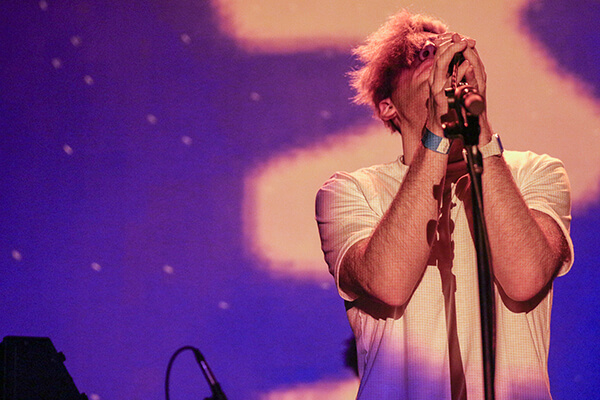
So how did you meet Dave Harrington originally?
A. We crossed paths the first time when we were both in Boston one summer, doing a music program. And he was playing some nasty, fast-and-loose funk bass and I was chugging along on some guitar in separate ensembles, and I just saw him onstage and I was like ‘that’s by bass player’. Back then he was really just a bass player—he wouldn’t pick up guitar until he started playing with Nico [Nicolas Jaar] in 2010 or something. We ended up as roommates and bandmates and we’ve been friends ever since. He was a big factor in me coming back to New York just so we could be collaborating. I think, these days, we’re all learning—and I’m talking about Dave and a lot of our contemporaries—how to both be that kind of screen-heavy editor, but then also make it a live thing, learn how to involve personalities into a recording, and learn how to bring the feeling of a community into a record. That’s been really satisfying, especially after a couple years of being more isolated and composing in a very atomized sense. Come back around and say, ‘I love making music with people, how do I do that? How do I produce without it being just me and a computer, but still call it an electronic record. What are the conditions for that?’ Because that’s the kind of music I want to make. Something that’s very lived in and human, bloody and sweaty and all of that, but also has an infinite amount of possibilities that you have with electronic production.
…Really, in the past couple EPs, that’s been the concept as much as I can deliver—to bring more minds in and more ears—and I think it’s without question made better productions and better songs… There’s this human quality, when you work with a specific group of people, you’re setting this album in a place and a time. The self-titled EP was a very New York record: Dave and Nico, recording with my live drummer at the time, Marshall Ryan. This record definitely reflects being in Europe. I worked with a guy [Louis McGuire] who’s been on the Berlin techno scene for the last 10 years and he knew that style of production in and out… He’s got this great duality of being a killer, really in-the-cut, pocketed live drummer, and then a techno nerd. So he was the perfect foil to me, because I’m playing that game from tones and textures and songwriting, but he really took my rhythm ideas and contextualized them so beautifully, and helped tell the story of where this record was made.
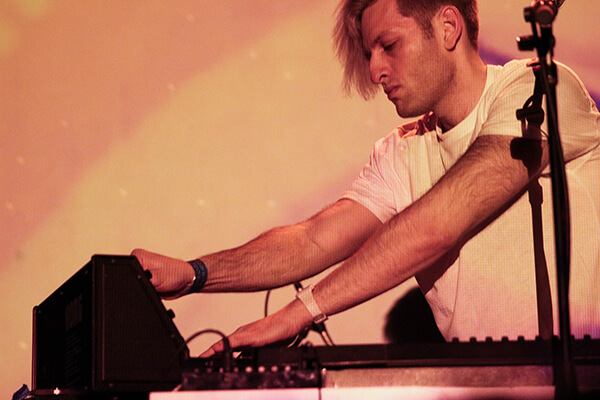
Was the whole record made in Berlin?
A. I would say it was mainly composed there, fully mixed there, but there were sessions here in New York… I feel as though the EP sounds like that, too. And there’s a lot more songs that I’ll be trickling out this year from the Berlin period that even strike that balance more obviously. They’re really like, ‘ok, this makes a lot of sense on a Berlin club floor, but this is a very New York atmosphere, undeniably.’
So you call your first EP a very New York record, and on [The State of Things] you say you can really hear the Berlin throughout it. And you can definitely hear the production difference between the two records, but what specifically about it do you think makes one New York and one Berlin?
A. I think that the self-titled record reflects the late 2000s indie community here a lot, because that’s what I was coming up in, where a lot of my primary ideas about recording and songwriting were formed, and there’s also an acoustic guitar song on that first record, which was made in 2008. We just dug it out from the vault; you can hear the F train go by on that one. I think on a literal level, there are just sounds in that first record that are made in NYC, and then culturally it’s reflecting an experience here….Whereas by contrast I was thinking about the club and dance floor directly when I was writing this EP because I was in Berlin and I was going out to those clubs and I was hearing those sounds everywhere. That was the culture all around me, and you can’t help but be a sponge. Ideally you want to be one, and I think some of the more vaulted subject matter does deal with more artistic concepts that I was being exposed to in the Berliner art scene. My roommates at the time were art gallerists so that exposed me to a lot of ideas in that community, which ended up influencing my lyric writing. And at the end of the day, it was meant to be performed in a certain kind of space and it was being developed while I was playing club shows and not indie concerts, which is just an entirely different means of performance. People are going there to have a physical experience more directly and there’s less of an emphasis on the hype around the artist and I like that. I mean I like the hype, too. I like the character building—all that Bowie shit. But there’s something very refreshing about an audience that’s there really for musical purposes. You can serve them up anything you want as long as they feel it. You don’t have to qualify it as much within a scene or within a set of scene expectations. I just had this amazing opportunity to try those songs out all over Europe, really from Dublin to Istanbul.
What were the kinds of venues that you were playing? I know that you talked about going to these techno clubs, but even in the new record you can still hear this underlying indie aesthetic. It’s not really techno.
A: Yeah and I didn’t want it to be. I just wanted to borrow some of the architecture of that material, but I would be playing in Lux in Lisbon, which is a massive club—600-700-person dance floor and some of the best acoustics in Europe. I played Berghain in the main room, opening for Dave and Nicolas on their first Darkside tour.
Wow how was that?
A: Incredible. I mean it’s like the biggest black hole sun bass you’ve ever heard in your life, and when it’s coming out of your rig, you feel like some kind of electric Jesus. So I played those kinds of places, I played little cinemas in Istanbul, I played smaller clubs in Berlin, more like 100-person venues. There’s a place called Backyard—did my EP release there a couple years back. It’s almost more the mentality of the audience than the club. It’s more the openness of a certain kind of electronic music-goer, who’s maybe interested in pop, but really loves to dance to techno, but also gets down with instrumental music. There’s a lot of space for that, I’ve found, in Berlin. And I think there’s space for that in the states, too; it’s just a culture that’s a little bit more in its infancy. Our generation is much more tapped in to cross-boundary music. It’s just physical spaces and real culture popping up around it to facilitate those experiences. That just takes time, even in the big cities like New York and LA.
Yeah that’s kind of a recurring thing with all the people I talk to, this sort of postmodern approach to music and how everything is overlapping and coming together and transcending preconceived notions about certain genres.
A: Yeah, but you know, how do you have the spaces for that to match? It’s confusing. I mean it works great at PS1 Warm Ups, or Trans Pecos, but you can’t really do that kind of shit at the old staples—it doesn’t really make sense. Cake Shop basement, something like that. Or the Living Room. That whole downtown strip, or even The Knitting Factory—all those places that were really kind of the center of Brooklyn indie half a decade ago. Those aren’t even really appropriate for the people coming up right now to express themselves.
Yeah that’s what I was going to ask you: where do you envision your music being most at home in New York?
A: I’m excited about playing at Good Room, because they are a club but they also have a stage, so they’re really capable of working that line, and similar to the kinds of venues I was playing in Europe. Since so many of the clubs that I cut my teeth in closed—Cameo, Death by Audio, Glasslands—normally I would say that I could have fun in those spaces… But it’s a new era, which I’m excited about. And I think that it’s going to be a discovery.
Original Photography for Frontrunner Magazine by Salvador Espinoza from Visuals at Bowery Ballroom, New York City Saturday April 2, 2016. All Rights Reserved.











Responses